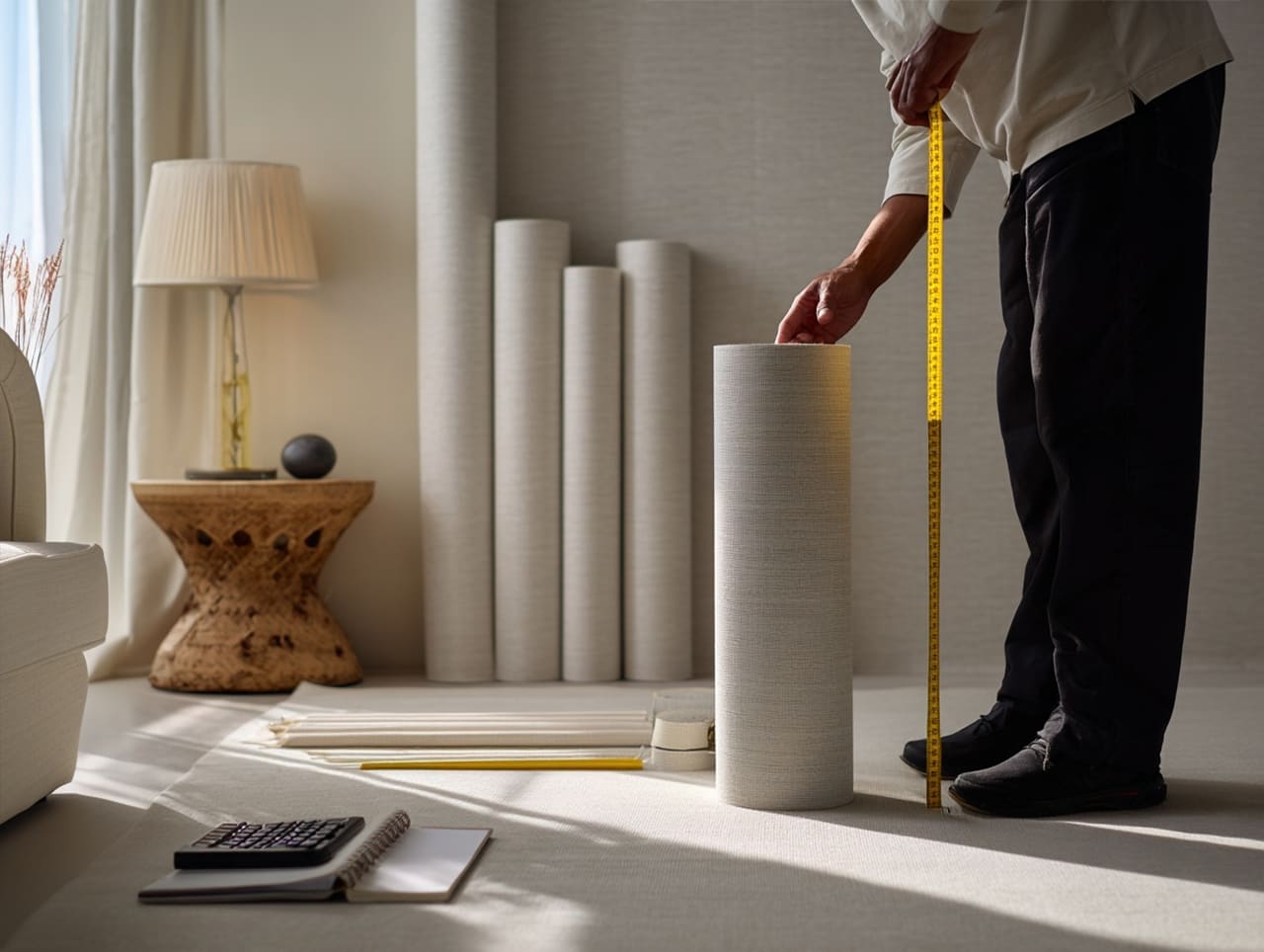Getting wallpaper measurements right isn’t rocket science, but it’s not exactly child’s play either. This wallpaper estimation guide walks you through measuring surfaces accurately, avoiding common mistakes like underestimating material or overlooking ceiling height, ensuring a seamless project from estimation to installation.
The Short Answer
If you don’t feel like learning too much about this process and would rather have your printshop or wallpaper supplier deal with quanities, then there are 3 key variables they will need to provide an accurate quote:
- Ceiling Height
- Combined Wall Widths
- Width of the Pattern/roll
Some quick notes that are covered in this article:
- Always order at least 15% more than you need
- Add 2 inches to ceiling height in case of irregularities
- Do not subtract doors/windows unless they are huge
- Think about size of pattern and what is required to match it
Visit our wallpaper calculator page for live area calculations based on wall dimensions.
A Deeper Look at Wallpaper Measuring
Whether you’re managing facilities for a corporate office or finally tackling that accent wall you’ve been dreaming about, accurate measurement is your foundation for project scope and budgeting success.
The good news? Once you understand how to measure for wallpaper using the professional strip method, calculating wallpaper needed becomes second nature.
Why Wallpaper Measurement Matters More Than You Think
Here’s what separates the pros from the weekend warriors: professionals count strips, not square feet. This single shift in thinking will save you more headaches than you can imagine.
In our own experience we’ve found that nearly a third of DIY measurers get their quantities wrong. That’s not a reflection of intelligence – it’s about using the wrong approach. Most people think in terms of covering area, like paint. But wallpaper works differently because of pattern matching, waste at cuts, etc.
Instead try thinking about wallpaper as panels or strips: vertical pieces that need to align perfectly. You’re not just covering surface area; you’re creating a seamless visual experience.
Common Wallpaper Measurement Mistakes That Cost Time and Money
Let’s talk about the mistakes that make seasoned installers shake their heads.
Ceiling Height and Roll Length Considerations
Modern wallpaper manufacturing has opened new possibilities, but it’s also created new considerations. Digital printing allows roll lengths up to 60 feet, but this flexibility comes with critical planning requirements.
Why Ceiling Height Determines Everything
Wallpaper installation follows one golden rule: each strip runs continuously from floor to ceiling. Unlike paint, you can’t patch wallpaper horizontally without visible seams. This makes ceiling height the most critical measurement in your entire project.
Here’s why partial rolls are your enemy:
- Horizontal seams are always visible, even with perfect matching
- Pattern alignment becomes nearly impossible across horizontal breaks
- Adhesion weakens at horizontal seams due to gravity
- Professional installers often refuse jobs requiring horizontal seaming
Measuring Varying Ceiling Heights
Many spaces feature varying heights - cathedral ceilings, split-levels, or architectural details. Here’s how to handle them:
- Measure at multiple points: Check height every 4 feet along each wall
- Use the maximum height: Always calculate based on your highest point
- Document variations: Note specific locations of height changes for your installer
- Communicate clearly: Provide detailed height specifications when ordering custom lengths
Practical Example: In a room with 10-foot standard ceilings and a 12-foot vaulted section, calculate all strips based on 12 feet. Yes, you’ll have waste on the standard-height sections, but you’ll maintain pattern continuity throughout.
The Window and Door Trap
Here’s a big one: don’t subtract windows and doors from your measurements unless they span the entire wall from floor to ceiling and wall to wall. Even then, only consider deductions if your pattern’s repeatable motif is small (under 6 inches).
Why? Pattern continuity trumps material savings. When you hang wallpaper, the pattern needs to flow seamlessly across the wall. If you cut around a window, you still need the same amount of material to maintain pattern alignment on both sides.
When deductions make sense: - The opening covers 70% or more of the wall surface - Your pattern has a small, repeatable motif (geometric, texture, or mini-print) - The pattern match is random or free-match
When to measure the full wall: - Large-scale patterns or motifs over 6 inches - Drop-match patterns requiring precise alignment - Any scenic or mural-style wallpaper - Built-in shelving or cabinetry (same rules apply)
Remember: large motifs complicate seam matching around obstacles, requiring full strips to maintain visual flow.
Pattern Scale and Practical Testing Methods
Pattern scale affects more than aesthetics – it directly impacts material requirements and installation complexity.
Understanding Pattern Impact
Large-scale patterns create dramatic visual impact but require careful planning. They typically need 15-25% additional material for matching, compared to 5-15% for smaller patterns.
The pattern repeat length determines how many usable drops you get per roll. A 36-inch repeat in a 9-foot room means significant waste, while a 12-inch repeat maximizes efficiency.
Testing Pattern Scale
Before committing to a large order, test your pattern choice using this low-cost technique:
- Print a black-and-white copy of your pattern at actual size
- Tape it to your wall at different heights and locations
- Step back and evaluate from various viewing distances
This simple test reveals whether your pattern scale suits your space. What looks perfect in a sample book might overwhelm your actual room. Suppliers can adjust pattern size if needed - most offer 25%, 50%, 75%, or 150% scaling options.
Irregular Spaces and Special Considerations
Not every wall is a perfect rectangle, and that’s where measurement gets interesting.
Sloped Walls and Unusual Angles
For sloped walls, measure the longest and widest dimensions, then ignore the slopes. You’ll waste material, but you’ll maintain pattern continuity and avoid complex calculations that often lead to errors.
Stairwell Measurement Example: 1. Measure the longest vertical drop (often 15-20 feet) 2. Measure total horizontal span including all wall sections 3. Calculate as if it’s one continuous flat wall 4. Expect 25-35% material waste - it’s normal for stairs
The diagonal nature means you can’t use standard strip calculations. Professional installers often charge premium rates for stair installations because of the measurement complexity and increased waste.
Multi-Room Projects and Accent Walls
When measuring multiple rooms or accent walls, batch-order all material simultaneously to ensure: - Consistent dye lots across all rolls - Pattern alignment between connected spaces - Adequate material for the entire project scope
Pro Tip: Our wallpaper calculator page accounts for multiple walls and dimensions.
The Mathematics of Wallpaper Overage
Professional installers follow a non-negotiable rule: order at least 15% extra material as your minimum overage. This isn’t waste – it’s insurance against costly delays and imperfect pattern matches.
Calculating Your Overage: - Small projects (under 8 rolls): Add 1-2 extra rolls minimum - Medium projects (8-20 rolls): Add 15% to your total - Large commercial projects: Order 20% overage
Concrete Example: For a 500-square-foot project requiring 12 rolls, add 2 rolls (roughly 15%) for a total order of 14 rolls. This covers installation errors, damaged panels, and future repairs.
Why 15% minimum? Under-ordering creates cascading problems: - Installation delays while waiting for material - Rushed installations increase error rates - No material for future repairs
Even with wider custom rolls (52 inches), maintain the 15% rule. Wider rolls may reduce seam count, but they don’t eliminate the need for installation insurance.
NOTE: For commercial projects, many facilities managers order 20% overage. The higher rate reflects the cost of business disruption if repairs require special orders. Store extra material properly: rolled (never folded), in climate-controlled conditions, away from direct sunlight.
How to Calculate Wallpaper Strips: The Professional Method
Let’s summarize all of these tips into a cohesive plan:
Step 1: Measure Wall Dimensions
Start with the basics, but do them right. Measure the widest width and highest height of each wall. Don’t assume walls are uniform – they rarely are.
Add 2 inches to both height and width measurements for trimming allowance. This gives you breathing room for adjustments during installation.
For walls that connect around corners, combine their widths. Wallpaper wraps corners, so treat connected walls as one continuous surface for width calculations.
Step 2: Calculate Strips Needed
Take your total wall width and divide by your wallpaper roll width. Standard rolls are 20.5 inches wide, but custom wallpaper can be printed up to 52 inches wide - a game-changer for reducing seams.
Standard Width Example: If your combined wall width is 144 inches and your wallpaper is 20.5 inches wide, you need 7.02 strips. Round up to 8 strips.
Custom Width Example: With the same 144-inch wall and a 52-inch custom roll, you’d need only 2.77 strips (round up to 3), dramatically reducing seams and installation complexity.
Roll Width and Custom Printing Considerations
The width of your wallpaper roll significantly impacts both aesthetics and installation. Here’s what you need to know:
Standard vs. Custom Roll Widths: - Traditional wallpaper: 20.5-27 inches wide - Custom digital printing: Up to 52 inches maximum printable area - Wider rolls = fewer panels = fewer seams = cleaner look
Custom print shops can optimize your material by doubling or tripling patterns on a single wide roll. This technique maximizes the printable area while maintaining pattern integrity. Always confirm your print shop’s maximum printable width - most quality shops offer the full 52-inch capability.
Benefits of Wider Rolls: - Reduced installation time (fewer strips to hang) - Minimal pattern interruption - Lower risk of seam visibility - Simplified pattern matching on large motifs
When ordering custom wallpaper, specify your desired roll width based on your wall dimensions and pattern scale. A skilled print shop can advise on the optimal width for your specific project.
Step 3: Determine Usable Strips Per Roll
This is where ceiling height becomes critical. Standard wallpaper rolls are typically 33 feet long, but digital printing allows custom lengths up to 60 feet.
Divide your ceiling height (plus trimming allowance) into the roll length to see how many strips you can get per roll.
Example: With 9-foot ceilings (108 inches plus 4 inches trimming = 112 inches), and a 33-foot roll (396 inches), you get 3.5 strips per roll. But patterns complicate this calculation.
Step 4: Account for Pattern Matching
Small patterns (under 25 inches repeat) typically yield 3 drops per roll. Large patterns might only give you 2-3 drops, depending on your ceiling height and the pattern repeat length.
Straight match patterns align horizontally across strips. Drop match patterns (also called half-drop) offset adjacent strips vertically by half the pattern repeat - think of brick layouts where each row shifts. Random match patterns require no special alignment, making them the most material-efficient choice.
Transform Your Space with Perfect Wallpaper Measurements
Mastering the art of measuring for wallpaper is your first step toward creating a stunning, seamless space that reflects your unique vision. By using the professional strip method, accounting for ceiling height, roll width, and pattern scale, and ordering at least 15% extra material, you set the stage for a flawless installation.
Whether you’re refreshing a single accent wall or transforming an entire commercial space, we’re here to help you measure, plan, and install with confidence.
Professional Consultation: Taking The Guesswork Away
Sometimes people are not great with spatial awareness or math. Articles like these make their heads hurt. If this describes you then your best bet is to adhere to the short notes in the beginning and contact a professional.
We’ve been printing wallpaper for over two decades and provide excellent quality and customer service. Call (212) 619-5446 and ask for Joseph. I will be glad to get you a proper estimate and plan for your custom wallpaper project!

